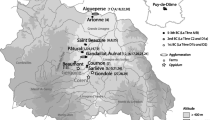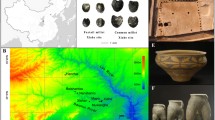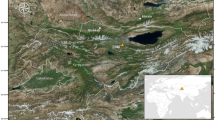Abstract
Recent archaeobotanical investigations of Late Neolithic sites in northern Greece have revealed a pattern as regards the crop parts represented at each site. Some sites appear to be dominated by chaff, mainly glume wheat chaff, while other sites are mainly characterised by cereal grain and pulses. This pattern could be the outcome of various factors: a. pre-depositional differential treatment of crops selecting for one category of plant remains to arrive at the site, b. depositional, therefore related to the type of activity represented at the excavated contexts and the use of space in relation to plants, and c. post-depositional factors such as erosion, or the type of features sampled. These alternative factors are considered in light of the preliminary results of the archaeobotanical investigation of seven Late Neolithic (5500–4000 cal. B.C.) sites from northern Greece. It is suggested that this pattern is the outcome of a differential use of space in relation to plants (storage, processing/food preparation, refuse disposal), probably related to aspects of the socioeconomic organisation of the settlements.



Similar content being viewed by others
References
Anagnostou, I., Vargas-Escobar A. (1994). Aνασκαϕή Aρκαδικού 1991: πρόταση προσέγγισης ɛνός ανασκαϕικού προβλήματος μɛ παράδɛιγμα τις πασσαλότρυπɛς (Excavations at Arkadikos 1991: an approach to an excavational problem based on postholes). AEMTH, 5, 371–382
van Andel, T.H., Runnels, C.N. (1995). The earliest farmers in Europe. Antiquity, 69, 481–500
Andreou, S., Fotiadis, M., Kotsakis, K. (2001). Review of Aegean Prehistory V: The Neolithic and Bronze Age of Northern Greece. In: Cullen, T. (ed) Aegean Prehistory: a review. American Journal of Archaeology Supplement 1, Archaeological Institute of America, Boston, pp 259–327
Andreou, S., Kotsakis, K. (1994). Prehistoric rural communities in perspective: the Langadas survey project. In: Doukelis, P.N., Mendoni, L.G. (eds) Structures rurales et societes antiques. Annales Litteraires de l’Université de Besançon, Paris, pp 17–25
Bailey, D. (2000). Balkan Prehistory. Exclusion, incorporation and identity. Routledge, London
Boardman, S., Jones, G. (1990). Experiments on the effects of charring cereal plant components. Journal of Archaeological Science, 17, 1–11
ter Braak, C.J.F. (1988). CANOCO—a FORTRAN program for canonical community ordination by (partial) (detrend) (canonical) correspondence analysis, principal components analysis and redundancy analysis, version 2.1. Pudoc, Wageningen
Brück, J. (1999). Houses, lifecycles and deposition on Middle Bronze Age settlements in southern England. Proceedings of the Prehistoric Society, 65, 145–166
Buchsenschutz, O. (1985). Aports de l’archéologie a l’étude des céréals: l’exemple de l’Europe tempérée a la fin de l’Age du Fer. In: Gast, M., Sigaut, F., Beutler, C. (eds) Les techniques de conservation des graines à long terme 3. C.N.R.S., Paris, pp 347–355
Chapman, J.C. (1981). The Vinca Culture of South-East Europe. British Archaeological Reports Series 117, Oxford
Chapman, J.C. (1989). The early Balkan village. In: Bökönyi, S. (ed) Neolithic of southeastern Europe and its Near Eastern Connections. Varia Archaeologica Hungarica, Budapest, pp 33–53
Chrysostomou, A., Poloukidou, C., Procopidou, A. (2003). Eπαρχιακή οδός Aψάλου-Aριδαίας. H ανασκαϕή του νɛολιθικού οικισμού στη θέση Γραμμή (The Apsalos-Aridea rural road. The excavation of the neolithic settlement at Grammi). AEMTH, 15, 512–524
Dennell, R. (1976). The economic importance of plant resources represented on archaeological sites. Journal of Archaeological Science, 3, 229–247
Dennell, R. (1978). Early farming in Bulgaria. British Archaeological Reports S451, Oxford
Douglas, M. (1966). Purity and danger. An analysis of concepts of pollution and taboo. Routledge, London
Efstratiou, N. et al. (1998). Excavations at the neolithic settlement of Makri, Thrace, Greece (1988–1996)—a preliminary report. Saguntum, 31, 11–62
French, D.H. (1971). An experiment in water-sieving. Anatolian Studies, 21, 59–64
Fuller, D. (2001). Ashmounds and hilltop villages: the search for early agriculture in southern India. Archaeology International, 2000/2001, 43–46
Gilman, P.A. (1997). Wandering villagers: pit structures, mobility and agriculture in southeastern Arizona (Anthropological Research Papers 49). Arizona State University, Tempe
Grammenos, D. (1975). Aπό τους προϊστορικούς οικισμούς της Aνατολικής Mακɛδονίας (From the prehistoric settlements of eastern Macedonia). Archaeologiko Deltio, 30, 193–234
Grammenos, D. (1980). Προϊστορικοί οικισμοί της Aνατολικής Mακɛδονίας (Prehistoric settlements of eastern Macedonia). Thrakika Chronika, 36, 95–100
Halstead, P. (1994). The north–south divide: regional paths to complexity in prehistoric Greece. In: Mathers, C., Stoddart, S. (eds) Development and decline in the Mediterranean Bronze Age (Sheffield Archaeological Monographs 8). J.R. Collis Publications, Sheffield, pp 195–219
Halstead, P. (1999). Neighbours from hell? The household in neolithic Greece. In: Hastead, P. (ed) Neolithic society in Greece. Sheffield Academic Press, Sheffield, pp 77–95
Halstead, P. (in press). Resettling the Neolithic: faunal evidence for seasons of consumption and residence at Neolithic sites in Greece. In: Bailey, D., Whittle, A., Cummings, V. (eds) New perspectives on Neolithic sedentism. Gotsen Institute of Archaeology, Los Angeles
Hillman, G. (1981). Reconstructing crop husbandry practices from charred remains of crops. In: Mercer, R. (ed) Farming practice in British prehistory. Edinburgh University Press, Edinburgh, pp 123–162
Hillman, G. (1984). Traditional husbandry and processing of archaic cereals in recent times: the operations, products, and equipment which might feature in Sumerian texts, part I: the glume wheats. Bulletin of Sumerian Agriculture, 1, 114–152
Hillman, G. (1985). Traditional husbandry and processing of archaic cereals in recent times: the operations, products, and equipment which might feature in Sumerian texts, part II: the free-threshing cereals. Bulletin on Sumerian Agriculture, 2, 1–31
Hodder, I. (1982). The present past: an introduction to anthropology for archaeologists. Batsford, London
Hodder, I. (1987). The meaning of discard: ash and domestic space in Baringo. In: Kent, S. (ed) Method and theory for activity area research. Columbia University Press, New York, pp 424–448
Hubbard, R.N.L.B., Housley, R.A. (2000). The environment and agriculture. In: Ridley, C., Wardle, K.A., Mould, C.A. (eds) Servia I, Anglo-Hellenic rescue excavations 1971–73 directed by Katerina Romiopoulou and Cressida Ridley. The British School at Athens, Supplementary Volume 32, pp 293–356
Ingold, T. (1985). The significance of storage in hunting societies. In: Gast, M., Sigaut, F., Beutler, C. (eds) Les techniques de conservation des graines à long terme 3. C.N.R.S., Paris, pp 33–59
Jones, G. (1987). Agricultural practice in Greek prehistory. Annual of the British School at Athens, 82, 115–123
Jones, G., Wardle, K., Halstead, P., Wardle, D. (1986). Crop storage at Assiros. Scientific American, 254, 96–103
Jones, G., Charles, M., Colledge, S., Halstead, P. (1995). Towards the archaeobotanical recognition of winter-cereal irrigation: an investigation of modern weed ecology in northern Spain. In: Kroll, H., Pasternak, R. (eds) Res Archaeobotanicae. Oetker-Voges-Verlag, Kiel, 49–68
Jones, G., Valamoti, S.M., Charles, M. (2000). Early crop diversity: a ‘new’ glume wheat from northern Greece. Vegetation History and Archaeobotany, 9, 133–146
Jones, M. (1985). Archaeobotany beyond subsistence reconstruction. In: Barker, G.W., Gamble, C. (eds) Beyond domestication in prehistoric Europe. Academic Press, London, pp 107–128
Jongman, R.H.G., ter Braak, C.J.F., van Tongeren, O.F.R. (1987). Data analysis in community and landscape ecology. Pudoc, Wageningen
Karkanas, P., Efstratiou, N. (2003). Aναζητώντας τον καθημɛρινό χρόνο στη νɛολιθική Mάκρη: μικρο-δομή και μικρο-στρωματογραϕία δαπέδων, ɛπιϕανɛιών χρήσης και ɛξωτɛρικών χώρων (In search of daily time in Neolithic Makri: micro-structure and micro-stratigraphy of floors, use surfaces and external space). AEMTH, 15, 1–8
Kent, S. (1999). The archaeological visibility of storage: delineating storage from trash areas. American Antiquity, 64, 79–94
Kotsakis, K. (1999). What tells can tell: social space and settlement in the Greek Neolithic. In: Hastead, P. (ed) Neolithic society in Greece. Sheffield Academic Press, Sheffield, pp 66–76
Kotsakis, K. et al. (1989). Carbon 14 dates from Mandalo, W. Macedonia. In: Maniatis, Y. (ed) Archaeometry: proceedings of the 25th International Symposium. Elsevier, Amsterdam, pp 679–685
Koukouli-Chrysanthaki, Ch., Treuil, R., Malamidou, D. (1997). Προϊστορικός οικισμός Φιλίππων «Nτικιλί Tας»: δέκα χρόνια ανασκαϕικής έρɛυνας (Prehistoric settlement of Philippoi “Dikili Tash”: ten years of excavations). AEMTH, 10β, 681–704
Kreuz, A. (1988). Searching for ‘single-activity refuse’ in Linearbandkeramik settlements. An archaeobotanical approach. In: Robinson, D.E. (ed) Experimentation and reconstruction in environmental archaeology. Symposia of the Association for Environmental Archaeology 9, Roskilde, Denmark, 1998. Oxbow, Oxford, pp 63–74
Miller, T. (1992). A cautionary note on the use of morphological characters for recognising taxa in wheat (genus Triticum). In: Anderson, P.C. (ed) Préhistoire de l’Agriculture: Nouvelles Approches Expérimentales et Ethnographiques. Editions du CNRS. Paris, pp 341–362
Murray, P. (1980). Discard location: the ethnographic data. American Antiquity, 45, 490–502
Moore, H.L. (1982). The interpretation of spatial patterning in settlement residues. In: Hodder, I. (ed) Symbolic and structural archaeology. Cambridge University Press, Cambridge, pp 74–79
Needham, S.P., Sorensen, M.L.S. (1988). Runnymede refuse tip: a consideration of midden deposits and their formation. In: Barrett, J.C., Kinnes, I.A. (eds) The archaeology of context in the Neolithic and Bronze Age: recent trends. University of Sheffield, Sheffield, pp 113–126
Okely, J. (1975). Gypsy women: models in conflict. In: Ardener S. (ed) Perceiving women. Malaby Press, London, pp 55–86
Papanthimou, A., Papasteriou, A. (1993). The prehistoric settlement at Mandalo: new evidence in the prehistory of W. Macedonia. Ancient Macedonia, 5, 1207–1216
Papaefthymiou-Papanthimou, A., Pilali-Papasteriou, A. (1997). Oι προϊστορικοί οικισμοί στο Mάνδαλο και στο Aρχοντικό Πέλλας (The prehistoric settlements at Mandalo and Archondiko Pellas). AEMTH, 10a, 143–158
Pappa, M. (1999). H οργάνωση του χώρου στους νɛολιθικούς οικισμούς της Bόρɛιας Πιɛρίας (The organization of space at the Neolithic settlements of north Pieria). Aρχαία Μακɛδονία, 6, 873–886
Pappa, M., Besios, M. (1999). The neolithic settlement at Makriyalos, northern Greece: preliminary report on the 1993–1995 excavations. Journal of Field Archaeology, 26, 177–195
Pappa, M., Halstead, P., Kotsakis, K., Urem-Kotsou, D. (in press). Evidence for large-scale feasting at Late Neolithic Makriyalos, N Greece. In: Halstead, P., Barrett, J. (eds) Food, cuisine and society in prehistoric Greece. (Sheffield Studies in Aegean Archaeology 5). Oxbow, Oxford
Peristeri, K., Touloumis, K. (1994). Aνασκαϕή στον Aρκαδικό Δράμας 1991: προκαταρκτικές παρατηρήσɛις για την οργάνωση του χώρου μɛ βάση τη διάκριση ɛσωτɛρικών και ɛξωτɛρικών χώρων (Excavations at Arkadikos Dramas 1991: preliminary observations on the organization of space through the discrimination of exterior and interior areas). AEMTH, 5, 359–370
Renfrew, J. (2003). Grains, seeds, and fruits from prehistoric Sitagroi. In: Elster, E.S., Renfrew, C. (eds) Prehistoric Sitagroi: excavations in northeast Greece, 1968–1970. Volume 2: The final report (Monumenta Archaeologica 20). Cotsen Institute of Archaeology, Los Angeles, pp 1–29
Sherratt, A. (1983). The Eneolithic period in Bulgaria in its European context. In: Poulter, A. (ed) Ancient Bulgaria: papers presented to the International Symposium on the Ancient History and Archaeology of Bulgaria, University of Nottingham, 1981. University of Nottingham, Nottingham, pp 188–198
Schiffer, M. (1987). Formation processes of the archaeological record. University of New Mexico Press, Albuquerque
Smilauer, P. (1992). Canodraw 3.0 User’s Guide. Microcomputer Power, New York
Toufexis, G. (in press a). Recent Neolithic research in the eastern Thessalian Plain, Greece. A preliminary report. International Symposium ‘The Aegean in the Neolithic, Chalcolithic and Early Bronze Age’, Urla, Turkey, 13–19 October 1997
Toufexis, G. (in press b). Σωστική ανασκαϕή στη χ.θ 3220–3316 της Aνατολικής Παράκαμψης Λάρισας-Nɛολιθική θέση στο Kοινοτικό Διαμέρισμα της Γαλήνης, Δήμος Πλατυκάμπου (Rescue excavation at Galini, Platycambos Larissas). Archaeologiko Deltio (Chronika) 54 (1999)
Treuil, R. (1992). Dikili Tash, Village Préhistorique de Macédoine Orientale 1. Bulletin de Correspondence Hellénique, Supplement 24. Ecole Française d’ Athènes, Paris
Tringham, R., Krstic, D. (1990). Selevac: A Neolithic village in Yugoslavia (Monumenta Archaeologica 15). Institute of Archaeology, University of California, Los Angeles
Valamoti, S.M. (2004). Plants and people in Late Neolithic and Early Bronze Age northern Greece: an archaeobotanical investigation. British Archaeological Reports, Series 1258, Oxford
Valamoti, S.M., Jones, G. (2003). Plant diversity and storage at Mandalo, Macedonia, Greece: archaeobotanical evidence from the Final Neolithic and Early Bronze Age. Annual of the British School at Athens, 98, 1–35
Valamoti, S.M., Charles, M.P. (forthcoming). Distinguishing food from fodder through the study of charred plant remains: an experimental approach of dung-derived chaff
van der Veen, M. (1992). Crop husbandry regimes (Sheffield Archaeological Monographs 8). J.R. Collis, Sheffield
Whittle, A. (1985). Neolithic Europe: a survey. Cambridge University Press, Cambridge
Whittle, A. (1996). Europe in the Neolithic. Cambridge University Press, Cambridge
Zohary, D., Hopf, M. (1994). Domestication of plants in the Old World. Oxford University Press, Oxford
Acknowledgements
This paper presents preliminary results of the ‘Investigation of Neolithic spatial and socio-economic organisation in northern Greece through the study of archaeobotanical remains’ project, undertaken by the author and generously funded by the Institute for Aegean Prehistory (INSTAP), the financial support of which is gratefully acknowledged. I also wish to deeply thank the excavators for entrusting me with the study of the material and for providing help during various stages of the archaeobotanical work: M. Besios, G. Chourmouziadis, A. Chrysostomou, N. Efstratiou, D. Kalintzi, K. Kotsakis, C. Koukouli, K. Papanthimou-Papaefthymiou, M. Pappa, K. Peristeri, A. Pilali and G. Toufexis. I also wish to thank S. Jacomet and the two anonymous reviewers for their constructive comments
Author information
Authors and Affiliations
Corresponding author
Rights and permissions
About this article
Cite this article
Valamoti, S.M. Grain versus chaff: identifying a contrast between grain-rich and chaff-rich sites in the Neolithic of northern Greece. Veget Hist Archaeobot 14, 259–267 (2005). https://doi.org/10.1007/s00334-005-0073-z
Received:
Accepted:
Published:
Issue Date:
DOI: https://doi.org/10.1007/s00334-005-0073-z




